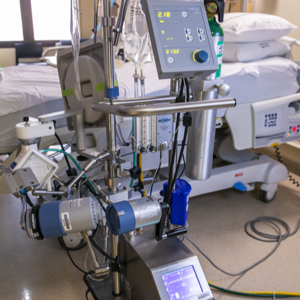By Marie Rosenthal, MS
Here are two sobering statistics: In the United States, nearly 90% of COVID-19 patients who qualified for, but did not receive, ECMO due to a shortage died despite being young and relatively healthy. At least 5 million children worldwide lost a parent or guardian because of COVID-19. In other news, researchers found that patients who received a palliative care consultation still received CPR if they needed it, and finally, Texas A&M found that in-person learning has not hurt college students—at least as far as COVID-19 is concerned.
Young, Healthy Adults Died From COVID-19 Due to ECMO Shortage
Nearly 90% of COVID-19 patients who qualified for, but did not receive, extracorporeal membrane oxygenation (ECMO) due to a shortage of resources during the height of the pandemic died in the hospital, despite being young with few other health issues, according to a new study (Am J Respir Crit Care Med 2022 Feb 25. doi:10.1164/rccm.202110-2399LE).
The Vanderbilt University Medical Center (VUMC) study, led by Whitney Gannon, MSN, the director of Quality and Education for the Vanderbilt Extracorporeal Life Support Program, in Nashville, Tenn., analyzed the number of patients referred for ECMO in one referral region between Jan. 1 and Aug. 31, 2021.
Approximately 90% of patients for whom health-system capacity to provide ECMO was unavailable died in the hospital, compared with 43% mortality for patients who received ECMO, despite both groups being of young age with few comorbidities.
 An ECMO machine. Image courtesy of VUMC
An ECMO machine. Image courtesy of VUMC“Even when saving ECMO for the youngest, healthiest and sickest patients, we could only provide it to a fraction of patients who qualified for it,” Ms. Gannon said. “I hope these data encourage hospitals and federal authorities to invest in the capacity to provide ECMO to more patients.”
Once a patient was determined to be medically eligible to receive ECMO, a separate assessment was performed of the health system’s resources to provide ECMO. When health-system resources—equipment, personnel and ICU beds—were not available, the patient was not transferred to an ECMO center and did not receive ECMO.
Among 240 patients with COVID-19 referred for ECMO, 90 patients (37.5%) were determined to be medically eligible to receive ECMO and included in the study. The median age was 40 years and 25 (27.8%) were female.
For 35 patients (38.9%), the health-system capacity to provide ECMO at a specialized center was available; for 55 patients (61.1%), the health-system capacity to provide ECMO at a specialized center was unavailable.
Death before hospital discharge occurred in 15 of the 35 patients (42.9%) who received ECMO, compared with 49 of the 55 patients (89.1%) who did not receive ECMO.
“Throughout the pandemic, it has been challenging for many outside of medicine to see the real-world impact of hospitals being ‘strained’ or ‘overwhelmed,’” said co-author Matthew Semler, MD, an assistant professor of medicine at VUMC. “When the number of patients with COVID-19 exceeds hospital resources, young, healthy Americans die who otherwise would have lived.”
In total, the risk for death for patients who received ECMO at a specialized center was approximately half of those who did not.
—The study was funded by NIH National Heart, Lung, and Blood Institute grants.
At Least 5 Million Children Lost a Parent or Caregiver From COVID-19
More than 5.2 million children worldwide have experienced the death of a parent or caregiver as a result of the pandemic, according to new estimates (Lancet Child Adolesc Health 2022 Feb 24. doi:https://doi.org/10.1016/S2352-4642[22]00005-0).
These estimates nearly doubled in the six months from May 1 through Oct. 31, 2021, compared with the first 14 months of the pandemic (March 1, 2020, through April 30, 2021).
The new study suggests that two out of three children orphaned from COVID-19 are adolescents aged 10 to 17 years. Because COVID-19–related deaths disproportionally affect men, three out of four children worldwide who experienced the death of a parent during the pandemic lost their fathers.
Overall, children who experience the loss of a caregiver have an increased risk for poverty, exploitation, sexual violence/abuse, HIV infection, mental health challenges and severe distress, and, in some contexts, increased vulnerability to gang involvement and violent extremism. The researchers called for evidence-based programs for children experiencing orphanhood to be urgently incorporated into pandemic response efforts, including programs that support economic strengthening, enhanced community and family support, and programs that avoid placing children in institutional care.
“Support for orphaned children must be immediately integrated into every national COVID-19 response plan. Such support should focus on three core components: preventing caregiver death through equitable COVID-19 vaccine coverage, containment and treatment; preparing families that are safe and nurturing to support affected children (such as through kinship care, foster care and adoption); and protecting children using evidence-based strategies to reduce risks of poverty, childhood adversity and violence,” said Susan Hillis, PhD, who completed this work during her tenure at the CDC.
Overall, the number of children affected by the death of a caregiver due to COVID-19 exceeded the number of reported COVID-19 deaths (5.2 million children compared with 5 million COVID-19 deaths).
“It took 10 years for 5 million children to be orphaned by HIV/AIDS, whereas the same number of children have been orphaned by COVID-19 in just two years. These figures do not account for the latest wave of the omicron COVID-19 variant, which may push the true toll even higher. We need to act swiftly to identify the children behind these numbers, so they can be given the support they need to thrive,” said senior author Lorraine Sherr, PhD, from University College London.
The number of children affected in the 20 countries studied ranged from 2,400 in Germany to more than 1.9 million in India. Calculations of estimated orphanhood cases per capita showed the highest rates were in Peru and South Africa, with eight and seven out of every 1,000 children affected, respectively.
The authors noted some limitations. Most notably, their estimates are generated by mathematical modeling and cannot measure actual numbers of children affected by a parent or caregiver’s death. They said future pandemic responses should include surveillance systems to monitor the numbers of children affected for every parental and caregiver death.
They also noted that their analysis is based on the best available data, but many countries do not have robust reporting systems for deaths or fertility.
Palliative Care Consultation Does Not Decrease COVID-19 Patients’ Chances of Receiving CPR
COVID-19 patients who receive a palliative care consultation are 5.6 times more likely to receive comfort care at the end of life and just as likely to receive CPR if needed as those who did not receive a consultation, according to a UT Southwestern study (Resuscitation 2022;170:230-237).
The researchers examined the data from the Viral Infection and Respiratory Illness Universal Study (VIRUS) registry of 3,227 patients who died from COVID-19 in ICUs across the United States. Comfort care is a plan to shift from invasive and painful therapies to comforting a patient at the end of life. They researchers examined data from March 30, 2020, to March 17, 2021.
 YTSW study finds palliative care consultation does not decrease CPR. Image courtesy of UT Southwestern Medical Center
YTSW study finds palliative care consultation does not decrease CPR. Image courtesy of UT Southwestern Medical Center“With comfort care, they’re more likely to have better pain management and better management of cough, anxiety and excessive salivation,” said lead author Sreekanth Cheruku, MD, an associate professor of anesthesiology and pain management at UT Southwestern, in Dallas. “The alternative is these patients would otherwise be on medications that cause pain while prolonging life. They would be on breathing machines even if they don’t really benefit from it, and they would be on modalities such as dialysis even if it’s not going to change anything, and all of these are painful therapies that you don’t really want to experience at the end of life.”
Comfort care also focuses on ensuring that families can be together at the end of life, and that religious and spiritual needs are met.
Comfort care was much more common in the group that received a consultation for palliative care, but both groups underwent CPR at the same rate, meaning that both sets of patients received similar levels of aggressive ICU care. Dr. Cheruku said the findings provide some of the strongest evidence yet that palliative care should be a priority in treating COVID-19 patients.
“Hospitals nationwide should incorporate palliative care services proactively into pandemic planning or into crisis planning, or into any type of planning where you have a large number of patients that experience end of life,” Dr. Cheruku said.
The study also found that Black COVID-19 patients were more likely to receive CPR at the end of life than patients who were not Black, a finding that echoes previous studies.
“The finding highlights the need for hospitals and hospital systems to improve their outreach into Black communities to establish better trust and provide education about end-of-life options. It is also important for hospital staff to communicate with Black patients at the end of life in ways that incorporate the cultural, social and religious beliefs of individual patients,” he said.
Palliative care is a medical specialty that helps patients with life-threatening conditions manage symptoms, relieve pain and improve quality of life during treatment. Comfort care is a plan to stop invasive and painful therapies when a patient is at the end of life and those therapies no longer help, shifting the focus to controlling pain and symptoms. Hospice care is a subset of comfort care.
Alexis Barina, MD, an assistant professor of internal medicine at UT Southwestern and a study author, said palliative care ensures a patient’s priorities and wishes are at the forefront, supports patients and their families through prolonged hospitalizations, and helps coordinate care among medical teams.
“Increasing access to palliative care in critically ill patients leads to more patient-centered care,” Dr. Barina said.
Nonathletic College Students May Be Less Likely to Contract COVID-19 Than Other Young Adults
Not only are student athletes less likely to contract COVID-19 than the rest of the student population, but nonathletic students are, in turn, less likely to catch SARS-CoV-2 than young adults in the general public, according to a new commentary co-authored by Texas A&M University researchers, in College Station.

The JAMA Open Network (2022 Feb 9. doi:10.1001/jamanetworkopen.2021.47810) article co-authored by the School of Public Health’s Rebecca Fischer, PhD, MPH, DTMH, and Benika Dixon, DrPH, MPH, expands on previous findings using data from the Southeastern Conference’s (SEC) 2020 football season that found athletes had a 50% reduction in risk in getting COVID-19 over college students who were not athletes.
Researchers have also determined nonathletic students had lower rates of COVID-19 infection than other young adults in the nation during the same period, suggesting that college students do not place themselves in a riskier situation by being on campus.
“There was this overwhelming assumption by parents, the public and school administrators that we’re sending students to college, and since they have to go to class together, we’re going to have more infections in that setting,” Dr. Fischer said. “We observed in this analysis that there were a variety of protection schemes. The more frequently the university promoted testing resulted in a lower risk to those students.”
The percentage of positive COVID-19 test results among U.S. young adults between the ages of 18 and 24 years increased from 7% to approximately 17% from August through December 2020. In comparison, the highest positivity among college athletes was 0.8%, while for college nonathletic students it was 6.6%.
This builds on a previous analysis of COVID-19 positivity rates among football players after SEC schools implemented protocols that required athletes to take three COVID-19 tests weekly. If athletes tested positive, they were required to observe quarantine. Researchers determined that SEC football players were not transmitting COVID-19 to each other because they were not around each other for longer than 15 minutes during the entire game.
“While it was a very simple analysis, what stood out to me was that, yes, our college athletes actually fared better in terms of COVID-19 test positivity than their classmates who were not in athletic programs,” Dr. Fischer said.
Dr. Fischer noted the earlier findings about college athletes are specific to football players. Additionally, the analysis didn’t tease out specific college mitigation efforts apart from the testing strategies that were used.
Dr. Fischer said continued study of college athletic programs in relation to the pandemic can help researchers, policymakers and event organizers understand how to safely create gatherings.




